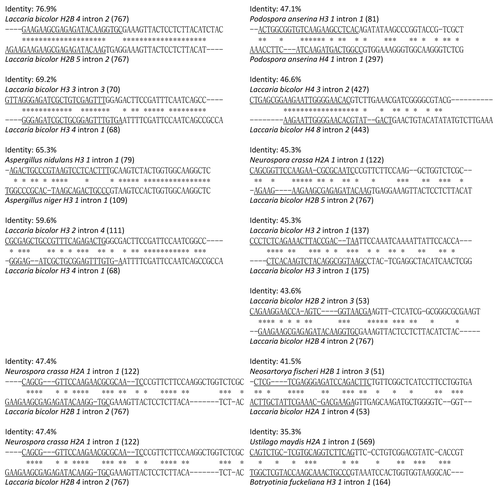Abstract
We have identified 305 introns in fungal histone genes. Among the 305 introns, 21 had sequence similarities to introns that have different insertion sites. These 21 introns formed 13 intron-pairs. Nine of the 13 pairs had low similarities (35.3%-47.4%) between the flanking DNA sequences of the introns, suggesting that intron-homing or homologous recombination was rare event in the histone intron distribution. Six of the 9 pairs consisted of the introns in the genes encoding the different histone families. On the other hand, 4 of the 13 pairs had 59.6-76.9% similarities between the flanking DNA sequences and the two intron sizes are similar. These 4 pairs consisted of the introns in the genes encoding the same histone family. Thus, in this analysis, intron-homings were not detected between the fungal genes encoding different histone families.
Each family of core histones H2A, H2B, H3 and H4 is much conserved among eukaryotes. Although animal and plant replication-dependent histone genes are generally intronless, basidiomycetes and filamentous ascomycetes (Pezizomycotina, which we misspelled as “Perizomycotina” in our previous paper) have introns in those histone genes.Citation2
We identified 305 introns in the four core histone genes of 24 fungal species and 85 intron insertion sites.Citation2 Based on the SSEARCH with Smith-Waterman similarity scores using 200 PRSS iterationsCitation1 among the 305 introns, 134 introns had sequence similarities to other introns with E-value < 0.02.Citation2
Among the 134 introns 113 (84%) had sequence similarities to the introns that Japanshare the same insertion site and 21 (16%) had sequence similarities to introns that have different insertion sites.Citation2 The intron-pairs with sequence similarity that share the same insertion site had the same or very similar DNA sequences in the flanking regions. Such intron-pairs were found between histone genes of a fungal species or of phylogenetically closely related species, strongly suggesting that they were inherited vertically from a common ancestor.Citation2 However, in our previous analysis, we did not compare the flanking region DNA sequences of the intron-pairs that have the different insertion sites. Thus, we compared those flanking regions in this article addendum.
Among the 21 introns that had sequence similarities to the introns located at different insertion sites, Neurospora crassa H2A 1 intron 1 had sequence similarity with three different introns, Laccaria bicolor H2B 4 intron 2 had similarity with three different introns, and Laccaria bicolor H2B 5 intron 2 had similarity with two different introns. Thus, we considered 13 intron-pairs (). First, we extracted the 5′ and 3′ flanking regions (each 24-nucleotides length) of each intron. Next, we concatenated the two flanking region sequences and aligned the flanking regions of two introns of the pair. Finally, we calculated identity scores between the flanking region sequences according to the following formula:
[number of identical sites in an alignment]/[total length of the alignment].
Nine of the 13 intron-pairs had low similarities (35.3%–47.4%) between the flanking DNA sequences of the introns (). It suggests that intron-homing or homologous recombination is a rare event in histone intron distribution. Among these nine pairs, six consisted of the introns in genes encoding different histone families. It possible that those introns had transferred by mechanisms other than intron-homing.
On the other hand, four of the 13 intron-pairs had similar intron lengths and similar flanking region sequences (). These introns may be distributed by intron-homing or homologous recombination. The four intron-pairs consisted of introns in the genes encoding the same histone protein family (). Therefore, in this analysis, intron-homings were not detected between the genes encoding the different histone families of fungi.
Figures and Tables
Figure 1 Alignments of DNA sequences of flanking regions of the 13 intron-pairs. Among the 305 fungal histone introns, 21 had sequence similarities to introns that have different insertion sites. Among these 21 introns, Neurospora crassa H2A 1 intron 1 had sequence similarity with three different introns, Laccaria bicolor H2B 4 intron 2 had similarity with three different introns, and Laccaria bicolor H2B 5 intron 2 had similarity with two different introns. Thus, we considered 13 intron-pairs. Underlined characters indicate the 5′-flanking region DNA sequence of each intron, the 3′ region is not underlined. Numbers in parentheses indicate the intron size (nucleotides).

Addendum to:
References
- Pearson WR. Empirical statistical estimates for sequence similarity searches. J Mol Biol 1998; 276:71 - 84
- Yun CS, Nishida H. Distribution of introns in fungal histone genes. PLoS One 2011; 6:16548